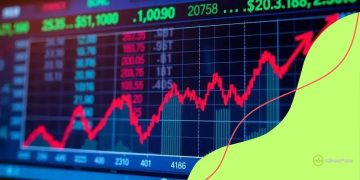Implications of the yield curve analysis for investors

The yield curve is a critical financial indicator that reflects interest rates for various maturities, helping investors analyze economic conditions and make informed investment decisions based on growth and recession expectations.
Implications of the yield curve analysis can significantly impact your investment decisions. But have you ever wondered how changes in the yield curve influence the broader economy? In this article, we’ll dive into the fundamentals of the yield curve and its effects on investors like you.
Understanding the yield curve: A quick overview
Understanding the yield curve is essential for investors trying to navigate the complexities of the financial markets. The yield curve illustrates the relationship between interest rates and different maturities of debt. Essentially, it provides a snapshot of what investors expect for future economic conditions.
Several key concepts arise when exploring the yield curve. When plotted, the curve can appear in different shapes: upward sloping, flat, or inverted. An upward sloping curve typically suggests that investors anticipate stronger economic growth, while an inverted curve may signal a potential recession.
Key benefits of a yield curve
Grasping the implications of the yield curve helps investors make informed decisions. Here are some crucial benefits:
- Risk assessment: Understanding the yield curve assists in assessing risks associated with investment choices.
- Timing investments: Knowing the curve can guide timing for buying or selling assets.
- Interest rate predictions: Investors can forecast future interest rates based on the curve’s shape.
- Economic signals: Analyzing the yield curve offers insights into economic conditions and expectations.
Moreover, the yield curve can act as a barometer for the overall economy. A steep curve often indicates healthy growth expectations, while a flattening or inverted curve signals caution. Following changes in the yield curve can also help investors identify shifting strategies in the market.
Types of yield curves
There are several different types of yield curves, which can provide distinct information:
- Normal yield curve: This curve slopes upwards, indicating that longer-term interest rates are higher than short-term rates.
- Inverted yield curve: When short-term rates exceed long-term rates, this inversion can indicate potential economic downturns.
- Flat yield curve: When short and long-term rates are similar, it suggests uncertainty among investors regarding future economic conditions.
In conclusion, understanding the yield curve is vital for investors. By analyzing its shape and behavior, they can better predict economic trends and adapt their strategies accordingly.
How the yield curve affects interest rates
The yield curve plays a crucial role in determining interest rates for loans and other financial products. It visually represents how the market views interest rates over different maturities. A normal yield curve indicates that longer-term borrowing costs are higher, reflecting the risks associated with time.
When the yield curve is steep, it typically signifies an expectation of rising interest rates in the future. This can lead to higher borrowing costs for individuals and businesses. Conversely, a flat or inverted yield curve can imply that short-term rates are higher than long-term rates, which often causes uncertainty about economic growth.
Impact on lending
Understanding how the yield curve affects interest rates helps explain why lenders may adjust their rates. Here are some points to consider:
- Cost of borrowing: As the yield curve shifts, banks may change their lending rates to maintain profitability.
- Mortgage rates: A changing yield curve impacts mortgage rates, affecting home buying decisions.
- Business loans: Companies also face fluctuating interest rates, influencing expansion plans based on borrowing costs.
Moreover, an understanding of interest rates helps consumers make informed financial decisions. For example, if banks predict higher rates due to a steepening yield curve, they may advance loans with higher interest to offset future risks. On the other hand, during periods of an inverted yield curve, banks may lower rates to encourage borrowing.
The connection to economic indicators
The yield curve is closely tied to various economic indicators. By analyzing trends, investors can gauge potential interest rate changes. Here are some critical connections:
- Inflation data: Rising inflation may prompt adjustments in interest rates.
- Employment rates: Strong job growth can signal the need for higher rates to prevent overheating.
- GDP growth: Increased economic growth expectations often lead to rising rates.
Furthermore, central banks monitor the yield curve carefully. They adjust monetary policy based on its movements, influencing overall economic conditions. By understanding these dynamics, both investors and consumers can navigate the financial landscape more effectively.
Investment strategies based on yield curve signals

Investment strategies based on yield curve signals can significantly enhance your portfolio’s performance. By understanding the different phases of the yield curve, investors can make timely decisions that align with market expectations. This strategic approach helps mitigate risks while maximizing returns.
When the yield curve is steep, it often indicates that long-term economic growth is expected. Investors can consider shifting investments into stocks or other growth-oriented assets during this time. This is because higher interest rates can lead to improved corporate earnings, making equities more attractive.
Understanding the phases
Since different yield curve shapes suggest various economic scenarios, it’s essential to adapt your investment strategies accordingly. Here are the primary phases:
- Growth phase: In a steepening yield curve, favor equities and cyclical stocks.
- Recession phase: During an inverted yield curve, consider safe-haven investments like bonds or commodities.
- Normal phase: A flat curve suggests diversifying assets across both stocks and bonds to balance risk.
Additionally, recognizing when to rebalance your portfolio based on yield curve movements can be crucial. For example, in a flattening yield curve scenario, investors might reduce exposure to high-risk assets in favor of lower-risk assets to protect against potential downturns. Transforming your portfolio in response to the yield curve requires both awareness and agility.
Using yield curve for sector rotation
Another effective strategy is sector rotation based on the yield curve. Different sectors react differently to interest rate changes. Here’s how you can align your investments:
- Financials: Generally perform well in a rising rate environment, making them a go-to sector during a steep curve.
- Utilities: These can be more appealing during periods of lower interest rates, as they typically offer stable dividends.
- Consumer discretionary: Benefits from increased consumer spending during growth phases signaled by a steep curve.
Staying informed about yield curve shifts can provide insights that enhance your investment approach. By monitoring these signals, investors can identify opportunities and position themselves wisely in different market conditions.
Predicting economic shifts with yield curve analysis
Predicting economic shifts with yield curve analysis is a valuable skill for investors and economists alike. The yield curve provides insights into future economic conditions and potential changes in interest rates. By examining the shape and movements of the yield curve, one can gauge market expectations regarding inflation and growth.
When the yield curve steepens, it usually suggests that investors expect higher growth and inflation in the future. In such cases, investors might adjust their portfolios to gain from possible economic expansion. This could mean increasing exposure to stocks or cyclical sectors that do well in growth periods.
Interpreting the yield curve
The yield curve can take on various shapes, each with its implications for economic predictions:
- Normal yield curve: Indicates a healthy economy, where long-term rates are higher than short-term rates, suggesting growth.
- Inverted yield curve: Often seen as a warning sign, this shape can mean a recession is approaching, as it reflects lower confidence in future growth.
- Flat yield curve: A flat curve signals uncertainty in the economy, as short and long-term rates are similar.
Furthermore, observing shifts in the yield curve can alert investors to potential market changes. For example, if the curve suddenly inverts, it may be time to shift to defensive investment strategies, as it indicates that market participants foresee a downturn.
Using yield curve data for forecasting
Data derived from yield curve analysis can be powerful when forecasting economic shifts. Here are some key applications:
- Interest rate predictions: Understanding the yield curve helps anticipate changes in central bank policies and interest rates.
- Investment strategy adjustments: Traders can reposition their investments based on trends observed in the yield curve.
- Economic growth expectations: The curve offers insights into how the market views future economic performance and activities.
Incorporating yield curve analysis into your investment strategy enables better forecasting and proactive decision-making. By staying aware of yield curve movements, you can enhance your ability to navigate shifting economic landscapes.
Real-world examples of yield curve implications
Real-world examples of yield curve implications can help illustrate how economic theories translate into market behavior. Investors often look at historical instances where changes in the yield curve significantly impacted investment strategies and economic policies.
For instance, during the late 2000s, an inverted yield curve was observed leading up to the financial crisis. This inversion indicated that investors expected a recession and prompted many to withdraw from risky investments. As a result, the stock market saw a decline, and many sectors faced downturns as consumer confidence waned.
Tech sector response
In another example, when the yield curve steepened in 2017, technology stocks rallied significantly. Investors interpreted this signal as an indication of robust economic growth ahead. As a result, many jumped into tech equities, leading to substantial gains. This instance shows how quickly sectors can react to changes in the yield curve based on anticipated economic conditions.
Impact on bond markets
The bond market is also heavily influenced by yield curve changes. For example, when the yield curve flattened in 2019, indicating uncertainty about future growth, many investors moved into safer assets, like government bonds. This shift is crucial as it demonstrates how yield curve movements lead to changing investor behaviors across asset classes.
Furthermore, the Federal Reserve closely monitors the yield curve as it reflects market expectations regarding interest rates and economic growth. In 2020, as the Fed slashed rates in response to the pandemic, observing the yield curve provided critical insights into recovery expectations. Many investors adjusted their portfolios based on the expectation of future growth and potential inflation.
These real-world examples highlight the significant role the yield curve plays in shaping investment strategies and economic forecasts. By studying historical patterns, investors can better understand how current yield curve movements might influence the markets.
FAQ – Frequently Asked Questions about Yield Curve Analysis
What is the yield curve?
The yield curve is a graph that shows the relationship between interest rates and different maturities of debt securities, indicating investor expectations about future economic conditions.
How does the yield curve impact investments?
The yield curve influences investment strategies by signaling expected interest rate changes, which can affect asset prices, especially stocks and bonds.
What does an inverted yield curve indicate?
An inverted yield curve often signals a potential recession, as it suggests that short-term interest rates are higher than long-term rates, indicating low confidence in future economic growth.
How can I use yield curve analysis to make better investment decisions?
By analyzing the shape and movements of the yield curve, investors can adjust their portfolios to align with market expectations, thereby mitigating risks and enhancing potential returns.





